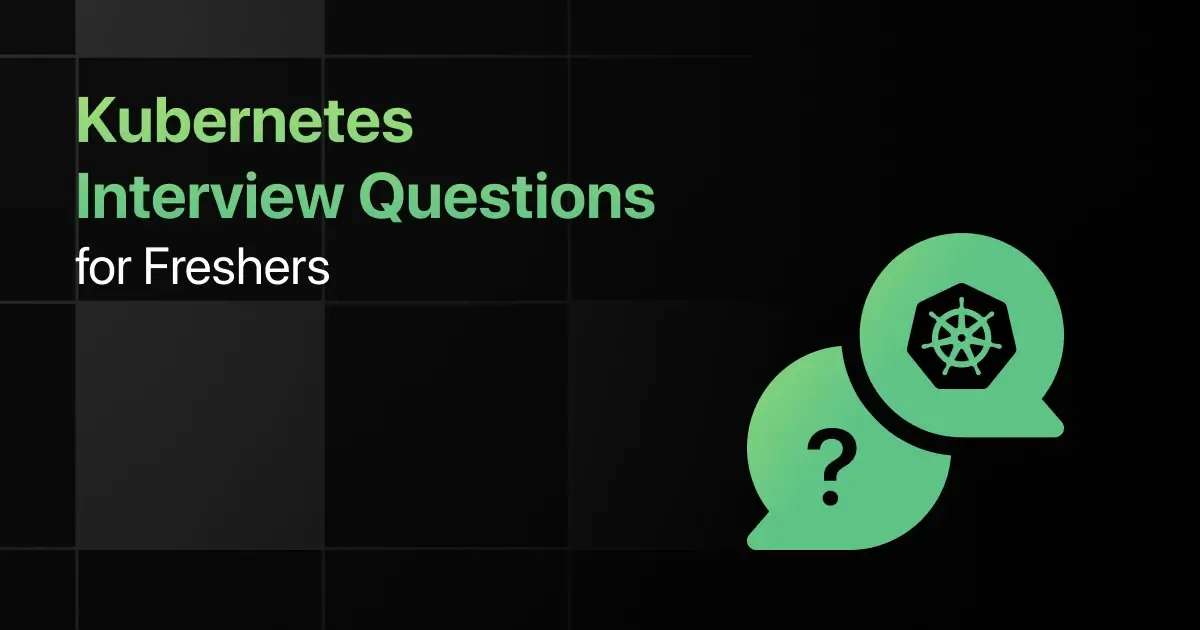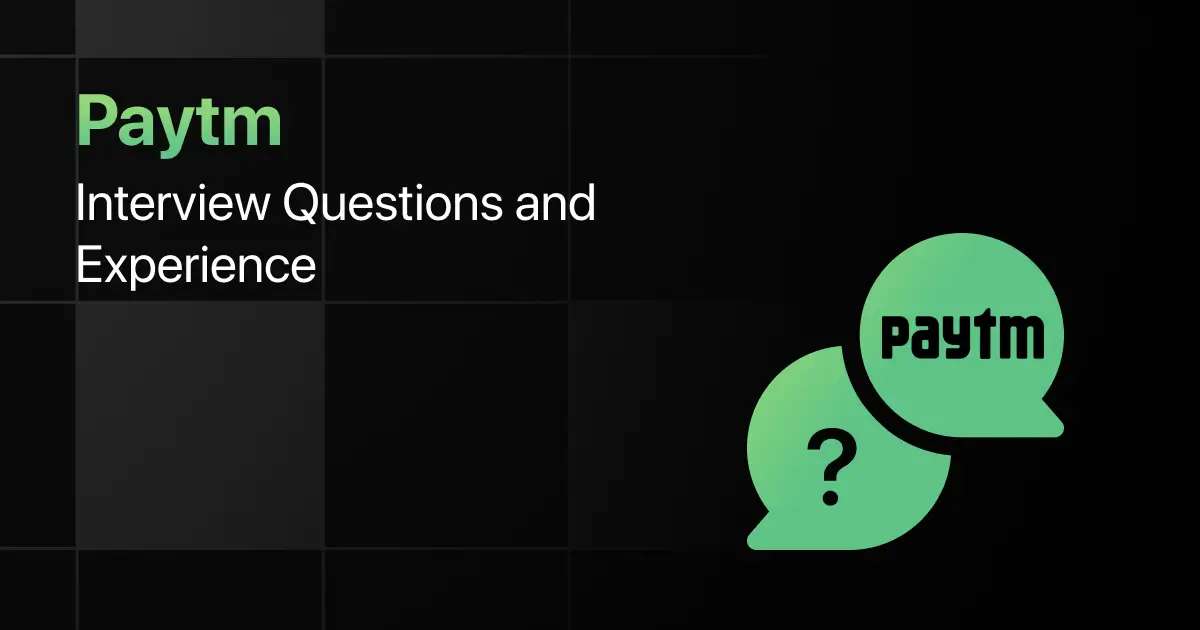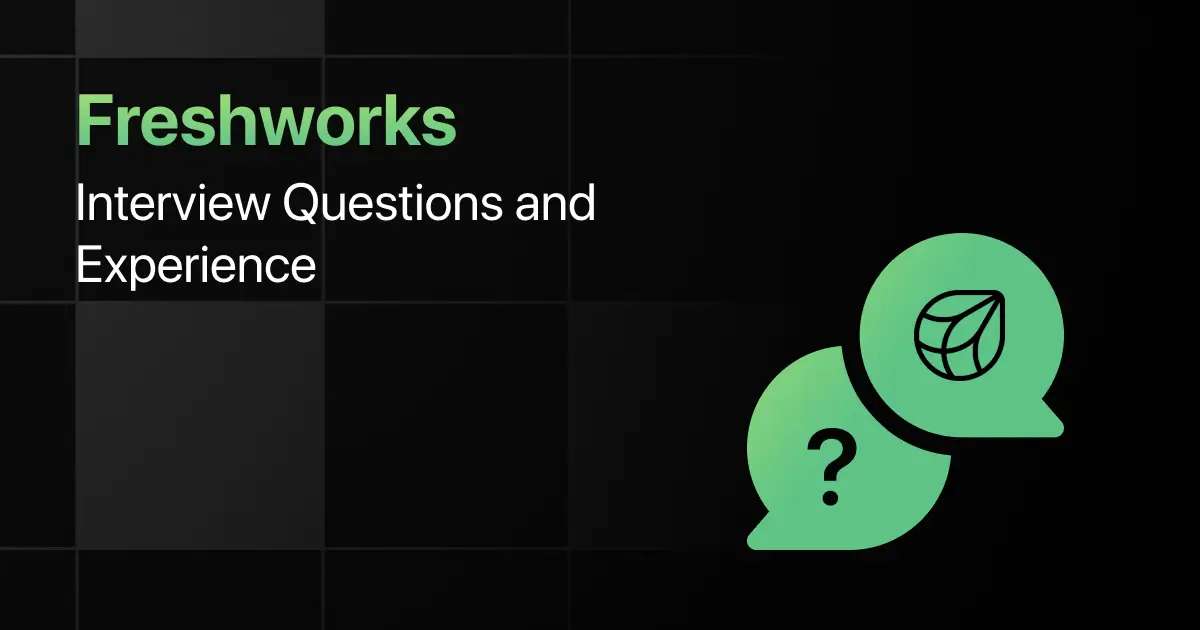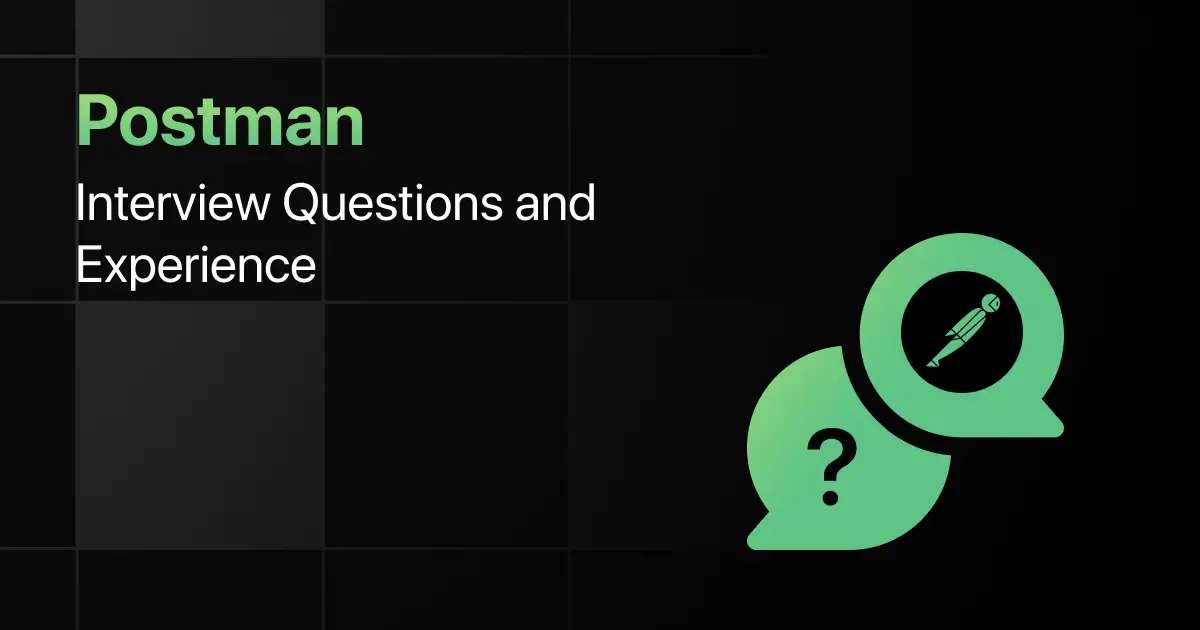Top Kubernetes Interview Questions for Freshers

Are you preparing for your first Kubernetes interview and wondering what questions you might face?
Understanding the key Kubernetes interview questions for freshers can give you more clarity.
With this guide, you’ll be well-prepared to tackle these Kubernetes interview questions and answers for freshers and make a strong impression in your interview.
Practice Kubernetes Interview Questions and Answers
Below are the top 50 Kubernetes interview questions for freshers with answers:
1. What is Kubernetes?
Answer:
Kubernetes (K8s) is an open-source container orchestration platform designed to automate deploying, scaling, and operating containerized applications across clusters of hosts.
2. What is a Kubernetes Pod?
Answer:
A Pod is the smallest deployable unit in Kubernetes. It is a wrapper for one or more containers, and all containers within a Pod share the same network and storage resources.
3. What is a Kubernetes Node?
Answer:
A Node is a worker machine in Kubernetes, which can be a virtual or physical machine. It runs containerized applications and is managed by the Kubernetes control plane.
4. What is a Cluster in Kubernetes?
Answer:
A Kubernetes cluster is a set of nodes that run containerized applications, managed by a control plane. It consists of both worker nodes and master nodes.
5. What is the role of the Kubernetes Master Node?
Answer:
The Master Node controls the entire Kubernetes cluster. It manages the scheduling of Pods, scaling, and overall state of the system through various components like the API server, scheduler, controller manager, and etcd.
6. What is Kubelet?
Answer:
Kubelet is an agent that runs on each Kubernetes Node. It listens to the API server for instructions and ensures that containers are running in Pods as expected.
7. What is the purpose of etcd in Kubernetes?
Answer:
etcd is a distributed key-value store that holds the entire state and configuration of the Kubernetes cluster. It ensures data consistency and reliability.
8. What is the Kubernetes API Server?
Answer:
The API Server is the frontend of the Kubernetes control plane. It exposes the Kubernetes API, processes requests, and validates them. It is the central point of interaction for all components.
9. What is a Deployment in Kubernetes?
Answer:
A Deployment in Kubernetes is an abstraction that defines how to deploy and manage stateless applications. It ensures the desired state by controlling the number of running Pods, handling scaling, and rolling updates.
10. What is a StatefulSet in Kubernetes?
Answer:
A StatefulSet is used for managing stateful applications. It provides guarantees about the ordering and uniqueness of Pods, making it ideal for applications that require stable network identities and persistent storage.
11. What is a DaemonSet in Kubernetes?
Answer:
A DaemonSet ensures that a copy of a Pod runs on all or some Nodes in the cluster. It’s typically used for services like logging, monitoring, or networking that should be present on every Node.
12. What is a Kubernetes Service?
Answer:
A Service is an abstraction that defines a logical set of Pods and a policy to access them. It allows Pods to be reached via a stable IP and DNS name, even if Pods are recreated.
13. What is the difference between a NodePort and LoadBalancer service in Kubernetes?
Answer:
- NodePort: Exposes a service on a static port on each Node’s IP address.
- LoadBalancer: Exposes the service externally via a cloud provider’s load balancer.
14. What is a Kubernetes Ingress?
Answer:
Ingress is a resource in Kubernetes that manages external access to services, typically HTTP/HTTPS. It provides routing rules to access services via a single IP address.
15. What is a ConfigMap in Kubernetes?
Answer:
A ConfigMap is a key-value store used to store configuration data that can be injected into containers in a decoupled way. It allows separation of configuration and application code.
16. What is a Secret in Kubernetes?
Answer:
A Secret is used to store sensitive information, such as passwords, tokens, and certificates. Secrets are encrypted and stored securely within the Kubernetes cluster.
17. How does Kubernetes handle storage?
Answer:
Kubernetes manages storage through Persistent Volumes (PVs) and Persistent Volume Claims (PVCs). A PV is a piece of storage in the cluster, and a PVC is a request for storage by a Pod.
18. What is a Persistent Volume in Kubernetes?
Answer:
A Persistent Volume (PV) is a storage resource in a Kubernetes cluster. Unlike ephemeral storage tied to Pods, PVs exist independently and can be used by Pods that request them.
19. What is a Persistent Volume Claim in Kubernetes?
Answer:
A Persistent Volume Claim (PVC) is a request for storage by a Pod. It specifies how much storage is needed and the access mode, and Kubernetes binds it to an available PV.
20. What is a namespace in Kubernetes?
Answer:
Namespaces are used to divide a Kubernetes cluster into multiple virtual clusters. They are a way to organize resources and manage access controls, often used in multi-tenant environments.
21. What is the difference between Deployment and StatefulSet?
Answer:
- Deployment: Manages stateless applications with no guaranteed Pod identity.
- StatefulSet: Manages stateful applications with stable identities and ordered Pod creation.
22. What is a Kubernetes Scheduler?
Answer:
The Scheduler is a component of the Kubernetes control plane responsible for selecting which Node will run a newly created Pod based on resource requirements, policies, and constraints.
23. What are labels in Kubernetes?
Answer:
Labels are key-value pairs attached to objects like Pods and Services. They provide a way to organize and select subsets of objects using label selectors.
24. What are annotations in Kubernetes?
Answer:
Annotations are key-value pairs attached to Kubernetes objects to store non-identifying metadata, such as build information, logging, or auditing details.
25. How do you scale a Deployment in Kubernetes?
Answer:
- Using kubectl: kubectl scale deployment <deployment-name> –replicas=<number-of-replicas>
- Update the Deployment manifest to change the replicas field.
26. What is the Horizontal Pod Autoscaler (HPA)?
Answer:
HPA automatically scales the number of Pods in a Deployment based on observed CPU utilization or custom metrics. It dynamically adjusts Pod count to match workload demands.
27. What is the Vertical Pod Autoscaler (VPA)?
Answer:
VPA adjusts the resource requests and limits (CPU and memory) for containers in a Pod based on observed usage. It ensures Pods get the appropriate resources without manual intervention.
28. What is kube-proxy?
Answer:
kube-proxy is a network proxy that runs on each Kubernetes Node, managing network rules to allow communication between Pods and Services. It forwards traffic to the appropriate Pods based on IP tables.
29. What is the difference between a ReplicaSet and a ReplicationController?
Answer:
- ReplicaSet: A newer controller that supports label-based selectors and manages Pod replication.
- ReplicationController: An older controller that ensures a specified number of Pod replicas are running, but uses equality-based selectors.
30. What is a Helm Chart?
Answer:
Helm is a package manager for Kubernetes, and a Helm Chart is a collection of files that describe a set of Kubernetes resources. Charts enable easy deployment and version control of applications.
31. How does Helm work in Kubernetes?
Answer:
Helm works by deploying Charts into Kubernetes clusters via Helm Releases. It allows users to manage, upgrade, and rollback Kubernetes applications with ease.
32. What is RBAC in Kubernetes?
Answer:
Role-Based Access Control (RBAC) in Kubernetes is used to define which users or service accounts have access to specific resources or actions within a namespace or across the cluster.
33. What are Kubernetes Volumes?
Answer:
A Volume in Kubernetes is a directory accessible by containers in a Pod. It can be ephemeral (lives and dies with the Pod) or persistent, providing long-term storage.
34. What is the Kubernetes Dashboard?
Answer:
The Kubernetes Dashboard is a web-based UI that allows users to manage and monitor their Kubernetes cluster. It provides insights into resource usage, application health, and more.
35. What is a Taint and Toleration in Kubernetes?
Answer:
Taints allow Nodes to repel certain Pods, while Tolerations allow Pods to be scheduled on those Nodes. They are used for workload isolation or dedicated Nodes for specific tasks.
36. What is an Init Container?
Answer:
Init containers are special containers that run before the application containers in a Pod. They are used to perform initialization tasks like setting up environments or data that the main containers depend on.
37. What is the difference between a Pod and a Container?
Answer:
- Container: A lightweight runtime unit that packages an application and its dependencies.
- Pod: A Kubernetes abstraction that wraps one or more containers, sharing network and storage resources.
38. What is kubeadm?
Answer:
kubeadm is a tool that simplifies the process of setting up a production-ready Kubernetes cluster. It helps bootstrap the control plane and worker nodes.
39. What is Kubectl?
Answer:
Kubectl is a command-line interface used to interact with a Kubernetes cluster. It allows users to deploy applications, inspect resources, and troubleshoot issues.
40. What is a ResourceQuota in Kubernetes?
Answer:
A ResourceQuota is a mechanism to limit a namespace’s total resource consumption (like CPU, memory, storage) to avoid over-provisioning and ensure fair resource usage across applications.
41. What is the difference between Minikube and Kubeadm?
Answer:
- Minikube: A tool that allows you to run a single-node Kubernetes cluster on a local machine for testing and development.
- Kubeadm: A tool for setting up multi-node production Kubernetes clusters.
42. What is a Kubernetes Operator?
Answer:
An Operator is an extension of Kubernetes that allows you to manage complex stateful applications by encapsulating domain-specific knowledge and automating operational tasks.
43. What is the difference between a Service and an Ingress?
Answer:
- Service: Provides internal or external access to Pods via a stable IP.
- Ingress: Manages external access to services, typically HTTP/HTTPS, and provides routing based on URL paths or hostnames.
44. What is Helm Tiller?
Answer:
Tiller was the server-side component of Helm v2 that managed releases. It has been removed in Helm v3 to enhance security and improve usability by allowing direct interaction with the Kubernetes API.
45. What is a Job in Kubernetes?
Answer:
A Job in Kubernetes is a controller that creates one or more Pods and ensures that a specified number of them successfully terminate. It is used for batch or one-time tasks.
46. What is a CronJob in Kubernetes?
Answer:
A CronJob is a type of Kubernetes Job that is scheduled to run at a specific time, similar to cron jobs in Unix/Linux. It is used for periodic or time-based tasks.
47. What is a Custom Resource Definition (CRD)?
Answer:
A CRD is a Kubernetes API extension that allows you to define custom resources that behave like built-in Kubernetes objects. It is a way to introduce new resource types into a cluster.
48. How does Kubernetes handle container networking?
Answer:
Kubernetes networking follows a flat network model, where each Pod has its own unique IP address. It uses network plugins (like Calico, and Flannel) to handle communication between Pods, Nodes, and external systems.
49. What is a ServiceAccount in Kubernetes?
Answer:
A ServiceAccount provides an identity for Pods to interact with the Kubernetes API. It is used to grant Pods limited privileges instead of default credentials.
50. What are Kubernetes Admission Controllers?
Answer:
Admission controllers are plugins that govern and validate requests to the Kubernetes API server before objects are persisted. They enforce security policies, resource quotas, and more.
Final Words
Getting ready for an interview can feel overwhelming, but going through these Kubernetes fresher interview questions can help you feel more confident.
With the right preparation, you’ll ace your Kubernetes interview but don’t forget to practice concepts like Pods, Services, Deployments, and Helm charts-related interview questions too.
Explore More Kubernetes Resources
Explore More Interview Questions
- Python
- Java
- SQL
- React
- JavaScript
- C Programming
- HTML
- CSS
- Angular
- C++
- Spring Boot
- Node JS
- Excel
- C#
- DBMS
- PHP
- Linux
- Operating System
- MySQL
- Spring
- Flutter
- MongoDB
- Django
- React Native
- jQuery
- Bootstrap
- Embedded C
- DSA
- R Programming
- Hadoop
- .NET
- Power BI
- ASP.NET
- ASP.NET MVC
- Android
- Tableau
- MVC
- WordPress
- TypeScript
- Spark
- Kotlin
- Swift
- Golang
- Shell Scripting
- iOS
- Spring MVC
- Next JS
- AWS
FAQs
The most common interview questions for Kubernetes often include topics like pod management, services, deployments, and storage solutions, as well as questions about the architecture of Kubernetes.
The important Kubernetes topics freshers should focus on for interviews include basic concepts like pods, nodes, and clusters, as well as understanding services, deployments, and configuration maps.
Freshers should prepare for Kubernetes technical interviews by gaining practical experience with a local Kubernetes setup, using tools like Minikube or Kind, and familiarizing themselves with Kubernetes commands and YAML configurations.
Freshers can use strategies like breaking down the problem into smaller parts, referencing official Kubernetes documentation, and practicing common deployment scenarios to solve coding questions effectively.
Freshers should consider preparing for advanced Kubernetes topics in interviews, such as custom resource definitions (CRDs), Helm charts, and Kubernetes security practices, as these can set them apart from other candidates.
Related Posts


Paytm Interview Questions and Experience
Preparing for a Paytm interview requires a clear understanding of the company’s hiring process, the type of questions asked, and …
Warning: Undefined variable $post_id in /var/www/wordpress/wp-content/themes/placementpreparation/template-parts/popup-zenlite.php on line 1050







